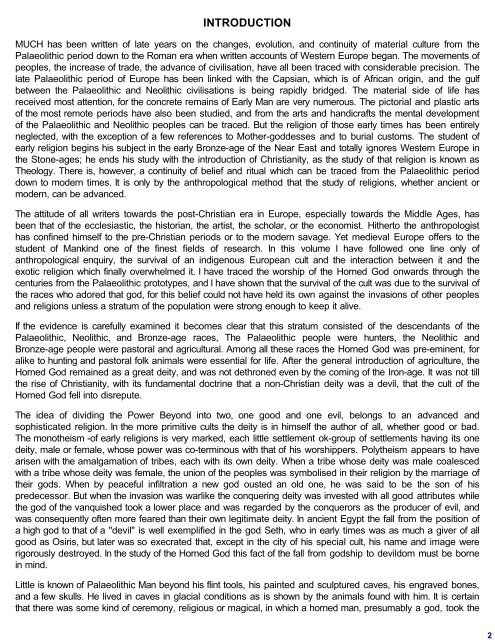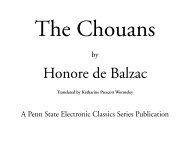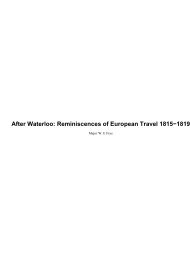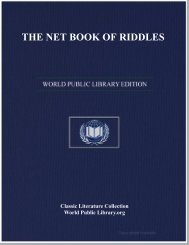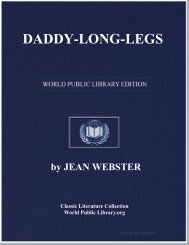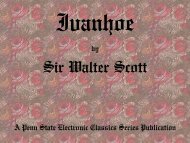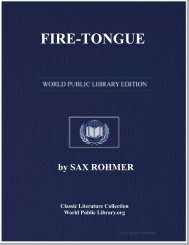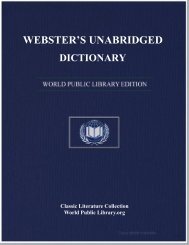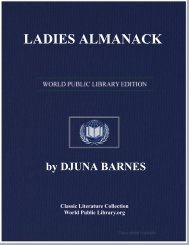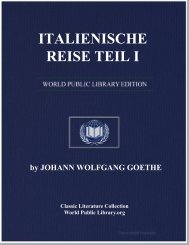THE GOD OF THE WITCHES - World eBook Library - World Public ...
THE GOD OF THE WITCHES - World eBook Library - World Public ...
THE GOD OF THE WITCHES - World eBook Library - World Public ...
You also want an ePaper? Increase the reach of your titles
YUMPU automatically turns print PDFs into web optimized ePapers that Google loves.
INTRODUCTION<br />
MUCH has been written of late years on the changes, evolution, and continuity of material culture from the<br />
Palaeolithic period down to the Roman era when written accounts of Western Europe began. The movements of<br />
peoples, the increase of trade, the advance of civilisation, have all been traced with considerable precision. The<br />
late Palaeolithic period of Europe has been linked with the Capsian, which is of African origin, and the gulf<br />
between the Palaeolithic and Neolithic civilisations is being rapidly bridged. The material side of life has<br />
received most attention, for the concrete remains of Early Man are very numerous. The pictorial and plastic arts<br />
of the most remote periods have also been studied, and from the arts and handicrafts the mental development<br />
of the Palaeolithic and Neolithic peoples can be traced. But the religion of those early times has been entirely<br />
neglected, with the exception of a few references to Mother-goddesses and to burial customs. The student of<br />
early religion begins his subject in the early Bronze-age of the Near East and totally ignores Western Europe in<br />
the Stone-ages; he ends his study with the introduction of Christianity, as the study of that religion is known as<br />
Theology. There is, however, a continuity of belief and ritual which can be traced from the Palaeolithic period<br />
down to modern times. It is only by the anthropological method that the study of religions, whether ancient or<br />
modern, can be advanced.<br />
The attitude of all writers towards the post-Christian era in Europe, especially towards the Middle Ages, has<br />
been that of the ecclesiastic, the historian, the artist, the scholar, or the economist. Hitherto the anthropologist<br />
has confined himself to the pre-Christian periods or to the modern savage. Yet medieval Europe offers to the<br />
student of Mankind one of the finest fields of research. In this volume I have followed one line only of<br />
anthropological enquiry, the survival of an indigenous European cult and the interaction between it and the<br />
exotic religion which finally overwhelmed it. I have traced the worship of the Horned God onwards through the<br />
centuries from the Palaeolithic prototypes, and I have shown that the survival of the cult was due to the survival of<br />
the races who adored that god, for this belief could not have held its own against the invasions of other peoples<br />
and religions unless a stratum of the population were strong enough to keep it alive.<br />
If the evidence is carefully examined it becomes clear that this stratum consisted of the descendants of the<br />
Palaeolithic, Neolithic, and Bronze-age races, The Palaeolithic people were hunters, the Neolithic and<br />
Bronze-age people were pastoral and agricultural. Among all these races the Horned God was pre-eminent, for<br />
alike to hunting and pastoral folk animals were essential for life. After the general introduction of agriculture, the<br />
Horned God remained as a great deity, and was not dethroned even by the coming of the Iron-age. It was not till<br />
the rise of Christianity, with its fundamental doctrine that a non-Christian deity was a devil, that the cult of the<br />
Horned God fell into disrepute.<br />
The idea of dividing the Power Beyond into two, one good and one evil, belongs to an advanced and<br />
sophisticated religion. In the more primitive cults the deity is in himself the author of all, whether good or bad.<br />
The monotheism -of early religions is very marked, each little settlement ok-group of settlements having its one<br />
deity, male or female, whose power was co-terminous with that of his worshippers. Polytheism appears to have<br />
arisen with the amalgamation of tribes, each with its own deity. When a tribe whose deity was male coalesced<br />
with a tribe whose deity was female, the union of the peoples was symbolised in their religion by the marriage of<br />
their gods. When by peaceful infiltration a new god ousted an old one, he was said to be the son of his<br />
predecessor. But when the invasion was warlike the conquering deity was invested with all good attributes while<br />
the god of the vanquished took a lower place and was regarded by the conquerors as the producer of evil, and<br />
was consequently often more feared than their own legitimate deity. In ancient Egypt the fall from the position of<br />
a high god to that of a "devil" is well exemplified in the god Seth, who in early times was as much a giver of all<br />
good as Osiris, but later was so execrated that, except in the city of his special cult, his name and image were<br />
rigorously destroyed. In the study of the Horned God this fact of the fall from godship to devildom must be borne<br />
in mind.<br />
Little is known of Palaeolithic Man beyond his flint tools, his painted and sculptured caves, his engraved bones,<br />
and a few skulls. He lived in caves in glacial conditions as is shown by the animals found with him. It is certain<br />
that there was some kind of ceremony, religious or magical, in which a horned man, presumably a god, took the<br />
2


